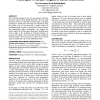Free Online Productivity Tools
i2Speak
i2Symbol
i2OCR
iTex2Img
iWeb2Print
iWeb2Shot
i2Type
iPdf2Split
iPdf2Merge
i2Bopomofo
i2Arabic
i2Style
i2Image
i2PDF
iLatex2Rtf
Sci2ools
CHI
2004
ACM
2004
ACM
Pointing at trivariate targets in 3D environments
We investigate pointing in true 3D environments where the target size varies in three spatial dimensions. We also study the effect of the user's physical movement angle on pointing performance. Results show that target size dimension along the primary axis of movement has a greater impact on performance than the other two dimensions. Movement angle also significantly affects performance, and changes the relative impact of the three target dimensions. Building upon recent results in the modeling of bivariate pointing, we propose and validate a new model that describes pointing at trivariate targets. This model also accounts for movement angle, and outperforms previously published models.
Bivariate Pointing | CHI 2004 | Human Computer Interaction | Movement Angle | Physical Movement Angle |
| Added | 01 Dec 2009 |
| Updated | 01 Dec 2009 |
| Type | Conference |
| Year | 2004 |
| Where | CHI |
| Authors | Tovi Grossman, Ravin Balakrishnan |
Comments (0)

